Contents
|
|
Introduction
Clients who have committed capital to a venture capital fund will generally need to make contributions over a specified time period to satisfy the terms of the agreement. You can track the payment information in Advisor View on the Committed Capital report.

To track the progress of contributions, you can enter the call dates for the committed capital. After capital is called, Advisor View will look back 10 days for a corresponding transaction from the funding account. The "look back" for the corresponding transaction will allow you to keep the account value intact while cash is in transit between the brokerage account and the private security.
Tracking committed capital requires some basic setup before the securities appear on the Committed Capital report. The basic steps are:
Set Up a Committed Capital Security
To set up a committed capital security, follow these steps:
-
On the Setup menu, under Security Settings, click Securities.
-
Under Actions, click Create New Security.
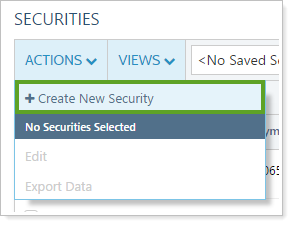
-
Enter the symbol of the security and click Next.
-
On the General tab, select the Treat as committed capital security check box. Click the Fund inception date box, and then use the calendar to select the inception date for the fund.

Note
When you select Treat as committed capital security, this security will have additional search options when you edit an account. You'll be able to see recently viewed symbols, or, as you type, you can see up to 20 symbols that match your entry.

-
Under Capital Call Dates, type in or use the calendar to select each known capital call date (both past and present) and then click Add. Repeat this step for each known capital call date..
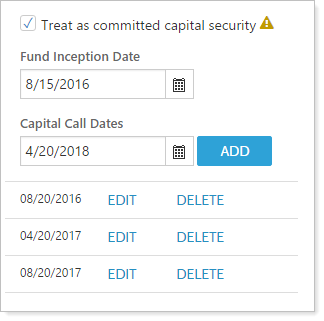
-
Complete any of the following:
Field More Information Description Type a description for the committed capital security. Symbol Type a symbol/ticker for the committed capital security. CUSIP Enter the CUSIP for the manual security. Dividend\ Income\ Rate\% Use the Dividend\Income\Rate\% manual security setting to add a yield percentage, or equivalent for the holding type, for a manual security. This value is used in calculations for current yield, annual dividend, interest rate, and annual income. By default, Dividend\Income\Rate\% is 0.
You see this data point:
-
When you add the Current Yield column to dynamic, PDF templates, client views, and dashboards, to Holdings reports that include the manual security.
-
On the Account Holdings and similar bulk reports and uploads.
-
On the Securities page when you add the Annual Income/Annual Dividend/Interest Rate column to a Securities page view.
Qualified status Choose whether the dividends are Non-Qualified, Qualified or Unclassified. State taxable Select this check box if the security is taxable at the state level. Federal taxable Select this check box if the security is taxable at the state level. -
-
On the Reporting tab, complete any of the following:
Field More Information Benchmark Choose a benchmark, if any, for the committed capital security. Treat security as cash When you select this check box, Advisor View will treat the security as cash and you can hide the security from all performance calculations. Report gains and losses on the Realized Gains/Losses report When you select this check box, Advisor View will add the realized gains and losses on the Realized Gains and Losses report based on the calculated in the security snapshot. Always report as IRR on Position Performance report If this check box is selected, all performance numbers should always show as IRR for the security, regardless of the overall report setting. Categories Choose an asset class, security, and/or subsector for the committed capital security. -
On the Custom Fields tab, if desired, complete the values for any custom fields you've created. For more information on custom fields, visit Custom Fields for Accounts, Reporting Groups, Households, and Securities.
-
When finished, click Save.
Assign a Committed Capital Security to an Account
Once you've created a committed capital security, follow these steps to assign it to an account:
-
On the Accounts menu, click Accounts.
-
Select one or more accounts where you want to add the security and then click Edit in the Actions list.
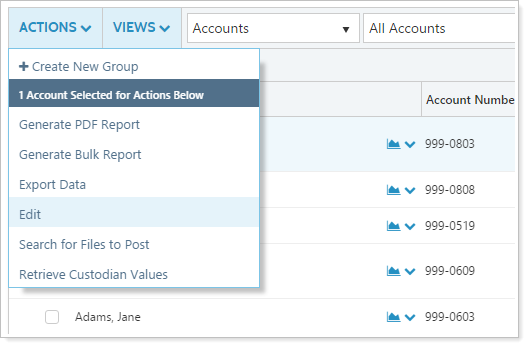
-
On the Edit Account panel, on the Advanced menu, click Committed Capital.
-
Type the security you want to add, then click Add Security.
For any securities that you created to be treated as committed capital securities, you can see recently viewed symbols or results that match the symbols you're typing. Start typing the security symbol you want to add and a list of up to 20 symbols that match your entry will display dynamically—or you can click in the box to see recently viewed symbols and up to 10 of your recently viewed symbols will appear (symbols that are currently in use will be excluded in order to prevent duplication).

-
In the Committed Capital box, type the amount of capital already committed. Click Show Call Dates to show additional call dates and enter amounts.
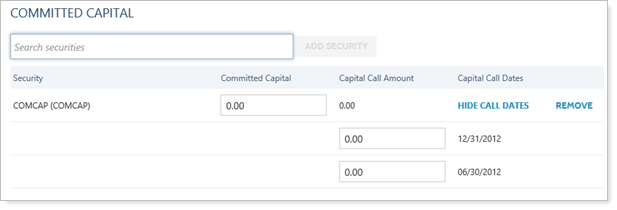
-
Click Save.
Creating Security Snapshots
After you've added the security into Advisor View and assigned it to an account, you can create a manual security snapshot and create transactions for the committed capital security.
To create a manual security snapshot:
-
On the Setup menu, under Security Settings, click Manual Security Snapshots.
-
In the Find data for list, select the account for which you want to create the manual security snapshot. You can only create a manual snapshot for accounts.
-
Click Create New Snapshot.

-
On the Create Snapshot page, click:
-
Actual if this snapshot is for actual data. Only one snapshot can be set to Actual per day for each security.
-
Estimate if you want to provide your client with an estimate so they can see their full financial picture, or if you have been given an estimated valuation prior to receiving complete data.
You can have both an actual and an estimated snapshot for each day.
-
-
Select Active to reflect this snapshot in reports. Otherwise the snapshot information will only be visible internally on the Manual Security Snapshot page.
-
Complete any of the following information:
Field More Information Security In this list of manual securities, click the security for which you want to create the snapshot. Funding account Choose the funding account. Advisor View will search this account 10 days before the date of the snapshot for a flow transaction of the same amount.
Date Choose the date where all of the transactions listed on this snapshot would be applicable to the date selected. This can be a future date if you have the data and want to report ahead. Global notes You can add notes to indicate activity in the account, and can choose how they will display:
-
Select this check box and enter a note if you want to include notes on any Transactions report generated for this snapshot.
-
Clear this check box if you want to include notes for specific snapshot values instead.
Notes The Notes fields for the specific fields are disabled if you have selected Global notes.
Clear the Global notes check box to use these notes fields and then enter specific notes for specific snapshot values. The notes will display if a transaction is generated for this snapshot.
Total market value
There are two options for reporting total market value:
-
Select this check box and type the current total market value for the security. The value you enter may be a positive or negative number. To enter a negative number, type a dash before the number. For more information on negative numbers, visit Entering Negative Amounts.
-
Clear this check box to track the value using contributions, withdrawals, and other details that have been entered historically. The value is calculated as:
Last Total Market Value Entered + Subsequent Flows = Current Total Market Value
Example
If the asset was entered with a beginning value of $25,000 and had a contribution of $5,000, your value would automatically be calculated as $30,000.
Note
If you use the automatic calculation, be aware that calculating total market value based on flow transactions can result in a performance return of 0%. To accurately calculate performance, capture capital appreciation by manually entering total market value.
For some alternative investments—particularly committed capital investments—fees may be charged up front, before any investments are made and before any capital is called. From the investor’s perspective, the value of that investment would be negative because the total value is the fees. After the first capital call and the first investments are made, the position would eventually turn to a positive value.
To support this scenario and many others, when entering the total market value for your manual securities, you have the option to enter negative values. To enter a negative value, simply type a dash before the number in the Total market value box.
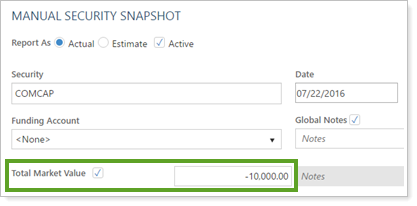
Reset cost basis Enter the beginning cost basis and adjust later as needed. This value must be positive, and will be shown in the following reports:
-
Holdings (Dynamic and PDF)
-
Security Cross-Reference (Dynamic and PDF)
-
Unrealized Gains/Losses (Dynamic and PDF)
-
Holdings bulk report
Unrealized Gains/Losses will be calculated as the initial cost basis entered in this field plus any subsequent contributions.
Return of principal Enter distributions that should reduce the cost basis, and the unrealized gains and losses will be reduced accordingly. Contributions/Capital Called Type the amount of contributions or capital the investor has paid to date. Other contributions Type additional investments that are outside of capital calls. Withdrawals/Distributions Type any withdrawals or distributions from the security. Fees Type any fees paid for the security. Misc expense Type any miscellaneous expenses paid for the security. Tax withheld Type any taxes withheld for the security. Interest paid Type any interest paid for the security. Dividends paid Type any dividends paid for the security. Long term realized gains Type any long-term realized gains for the security to track these values. Short term realized gains Type any short-term realized gains for the security to track these values. Reinvested Distributions Type any automatically reinvested distributions to be tracked. This improves accuracy of performance reporting by eliminating the need to add a withdrawal and deposit to track reinvested distributions and excludes such distributions from the account's flows.
Reinvesting distributions will result in increased cost basis, which will be reflected in the Committed Capital report.
Recallable Distributions Type any amount of distributions that are recallable. Recallable distributions will result in increase in remaining capital which will be reflected in the Committed Capital report.
Reinvested If this check box is not selected, the associated field—interest paid, dividends paid, long term realized gains, or short term realized gains—will be included as flows in reports.
If this check box is selected, the associated field will be excluded from flows in reports.
-
-
Click Save.
Running the Capital Call Report
You can run the dynamic version for the Capital Call report or add it as a section in your PDF reports. For more information on running this report or adding it to a PDF section, visit Committed Capital Report.


